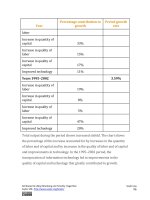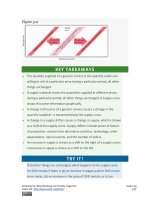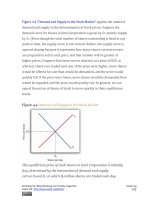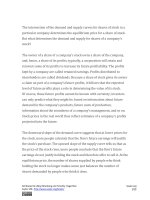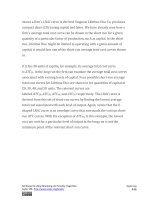Authors libby rittenberg 482
Bạn đang xem bản rút gọn của tài liệu. Xem và tải ngay bản đầy đủ của tài liệu tại đây (291.35 KB, 1 trang )
output, Mr. Gortari’s total cost is $400 (his total fixed cost); total revenue is
zero. Total cost continues to exceed total revenue up to an output of 1,500
pounds per month, at which point the two curves intersect. At this point,
economic profit equals zero. As Mr. Gortari expands output above 1,500
pounds per month, total revenue becomes greater than total cost. We see
that at a quantity of 1,500 pounds per month, the total revenue curve is
steeper than the total cost curve. Because revenues are rising faster than
costs, profits rise with increased output. As long as the total revenue curve
is steeper than the total cost curve, profit increases as the firm increases
its output.
The total revenue curve’s slope does not change as the firm increases its
output. But the total cost curve becomes steeper and steeper as
diminishing marginal returns set in. Eventually, the total cost and total
revenue curves will have the same slope. That happens in Figure 9.6 "Total
Revenue, Total Cost, and Economic Profit" at an output of 6,700 pounds of
radishes per month. Notice that a line drawn tangent to the total cost curve
at that quantity has the same slope as the total revenue curve.
As output increases beyond 6,700 pounds, the total cost curve continues to
become steeper. It becomes steeper than the total revenue curve, and
profits fall as costs rise faster than revenues. At an output slightly above
8,000 pounds per month, the total revenue and cost curves intersect again,
and economic profit equals zero. Mr. Gortari achieves the greatest profit
possible by producing 6,700 pounds of radishes per month, the quantity at
which the total cost and total revenue curves have the same slope. More
generally, we can conclude that a perfectly competitive firm maximizes
economic profit at the output level at which the total revenue curve and
the total cost curve have the same slope.
Attributed to Libby Rittenberg and Timothy Tregarthen
Saylor URL: />
Saylor.org
482
